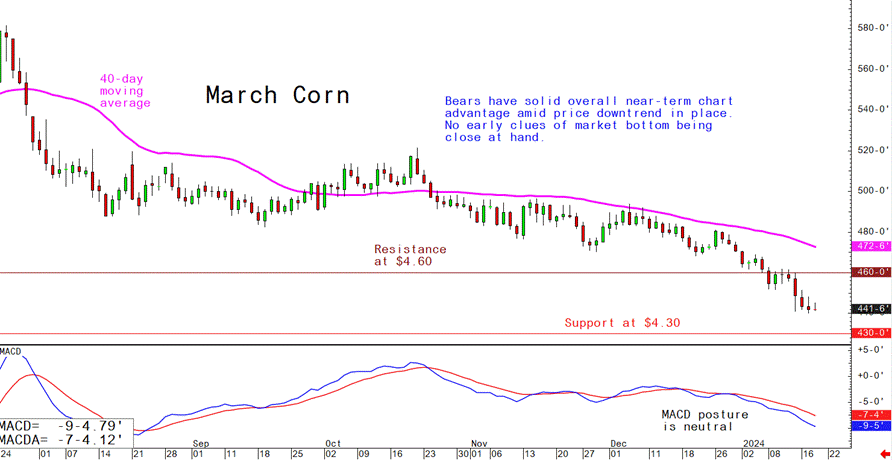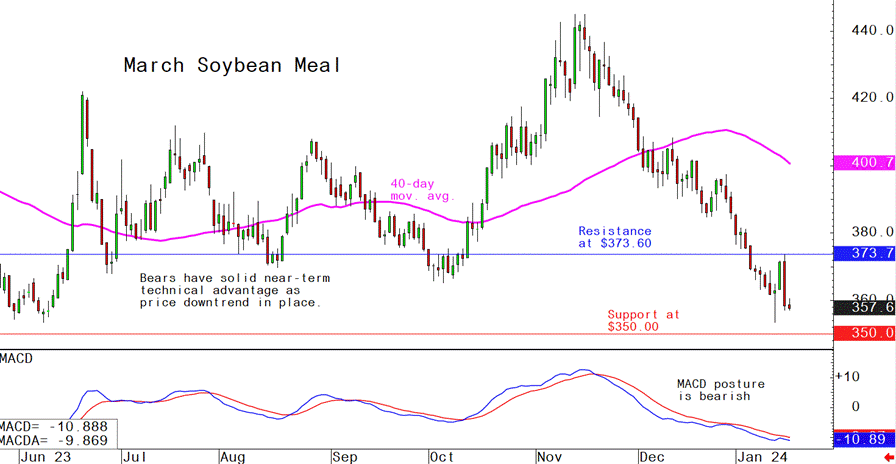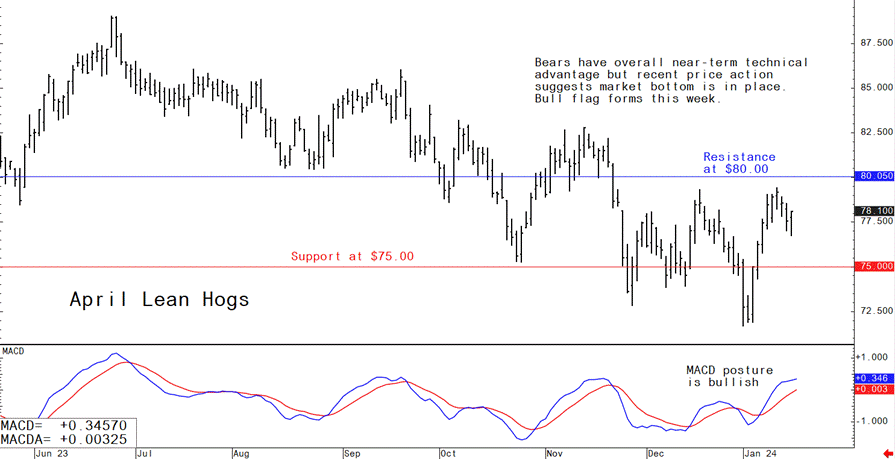



Pig outlook — Lean hog futures bulls still see some progress
Livestock analyst Jim Wyckoff shares pig news from around the worldApril lean hog futures prices have backed down from the January high, but that’s just a normal corrective pullback from recent good gains. In fact, recent price action on the daily chart shows a bullish flag or pennant pattern has formed. The latest CME lean hog index is up another 49 cents to $67.34 (as of Jan. 16), marking the sixth gain in the last seven days. The index appears to have put in a seasonal low, posted at the beginning of January. Wholesale pork prices continue to show strength, which is impressive given the increase in supplies following last week’s winter storm.
China’s December pork imports fall sharply from year-ago
China imported 90,000 MT of pork during December, unchanged from November but 54.3% less than last year. For 2023, China imported 1.55 MMT of pork, down 11.7% from the previous year.
China’s pork production reaches record in 2023
China produced a record 57.94 MMT of pork in 2023, official data showed, after farmers ramped up slaughter during the last quarter to cut losses amid an oversupply of pigs. Annual pork output expanded 4.6% from the previous year, as slaughter rose 3.8% to 726.62 million head. Pork production in the fourth quarter totaled 14.93 MMT, up 7% from the same period in 2022. China’s beef output rose 4.8% to 7.53 MMT, poultry meat production rose 4.9% to 25.63 MMT and mutton increased 1.3% to 5.31 MMT in 2023.
In November, US pork exports reached new records in key markets
The surge in US pork exports is driven by outstanding performances in Mexico, Central America, and Colombia. These figures are based on data from USDA and compiled by the U.S. Meat Export Federation (USMEF).
Pork exports to Mexico, a leading market, reached a value record in November, marking a 5% increase from the previous year. Export volume also surged by 14%, totaling 100,313 metric tons, making it the second-largest on record, with only October 2023 surpassing it.
Central America saw big growth in pork exports in November, with significant increases in Honduras, Guatemala, and El Salvador. Shipments to the region surged by 35% compared to the previous year, reaching 16,565 metric tons, setting monthly records.
South Korea also experienced substantial growth in pork exports in November, up by 19% compared to the previous year, with shipments totaling 17,406 metric tons.
Oceania witnessed a notable rebound in pork exports throughout 2023, and this trend continued in November, with shipments nearly tripling compared to the previous year, reaching 6,414 metric tons, which is an impressive 186% increase.
In terms of production, exports accounted for 30.1% of total pork production in November, with muscle cuts making up 26.2%. Both figures increased by approximately 1 percentage point compared to the previous year.
USDA report: livestock and poultry, world markets and trade
Competition Tightens for Leading Pork Exporter
The revised 2024 forecast of pork shipments by U.S. and EU, the world’s top two exporters, are nearly on par for the first time since 2015. U.S. and EU exports for 2024 are both revised lower compared to the October forecast. However, the gap is narrowed for these competitors as U.S. shipments are revised only 1 percent lower whereas EU shipments are revised 3 percent lower. The downward revisions for U.S. and EU exports are driven by expected weaker shipments to China, the world’s largest importer.
Continued weak demand by China reduces export opportunities, particularly for the EU. Although U.S. export volumes to China remain a significant part of total exports, U.S. share of exports to China is less than for the EU. In 2022, U.S. shipments to China accounted for 10 percent of total exports, while EU shipments to China accounted for 27 percent of total exports. In addition, EU production has declined in recent years and is revised 2 percent lower in 2024, tightening exportable supplies.
Global pork production for 2024 is revised down 1 percent from the October forecast to 114.2 million tons on lower output in China, the EU, and Brazil. China production is revised lower as continued weak demand discourages expanding domestic production. EU production is revised lower on continued regulatory pressure and changing consumer preferences. Brazil production is revised lower as imports from top market China continue to weaken. U.S. production is virtually unchanged with declines in the farrowings offset by increased pigs per litter. Global pork exports for 2024 are lowered 2 percent from the October forecast to 10.2 million tons as the EU, United States, and Brazil increasingly compete for lower China imports. Although U.S. exports remain strong to many core markets, including Mexico and Canada, aggregate exports are revised lower against weak import demand from Japan and China. United Kingdom exports are also revised lower on declining demand from the European Union.
China’s 2023 meat imports slip below year-ago
China imported 566,000 MT of meat during December, up 1.6% from November but nearly 19% below year-ago. For 2023, China imports 7.38 MMT of meat, down 0.3% from the previous year.
The next week’s likely high-low price trading ranges:
April lean hog futures--$75.00 to $82.00 and with a sideways-higher bias
March soybean meal futures--$350.00 to $375.00, and with a sideways-lower bias
March corn futures--$4.35 to $4.60 and a sideways-lower bias
Latest analytical daily charts lean hog, soybean meal and corn futures












